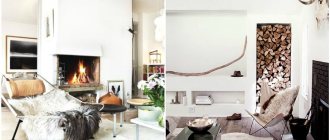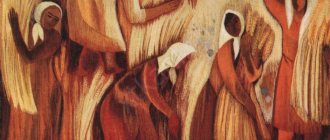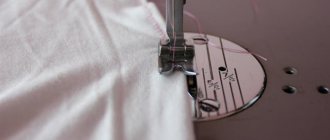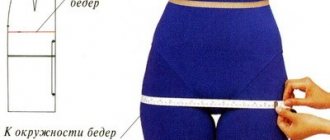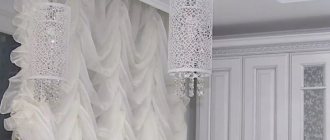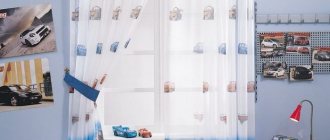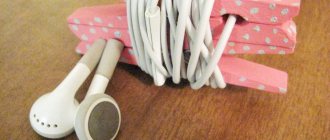Sewing a bedspread with your own hands is not only a way to save on a factory product, but also an opportunity to bring a piece of your soul into the interior. A bedroom is a place where a person spends a significant part of his life, so it is important to make this space as comfortable as possible for relaxation.
Any textile products create an extraordinary atmosphere of comfort in the room; making them yourself using detailed instructions is very simple. Today we will talk about how to create a bedspread.
DIY bedspread
How to choose fabric for a bedspread?
Of course, for most people, the main criterion for choosing a particular fabric is its combination with other interior items. At the same time, it is worth paying attention to the texture of the material and its quality. We will look at the most popular types of textiles used to create blankets.
Table No. 1. Fabrics for bedspreads
| View, illustration | Description |
| Fur | There are both artificial and natural fur fabrics - in both cases, such a product will be very warm. However, these types of bedspreads are not suitable for everyone. After all, they are quite difficult to wash, and sometimes you even have to use dry cleaning services. |
| Wool | As in the previous case, woolen products will be very warm. In addition, they have good wear resistance and better absorb excess moisture. It is worth noting that such material has a different texture, it can be a little thicker or thinner, and the final appearance of the product depends on this. The finer the wool, the lighter and airier the blanket will be. |
| Silk | This is also a fairly popular material, which is used in the manufacture of various bedding. This blanket will be comfortable to cover yourself with, silk is very pleasant to the skin. The main disadvantage is that silk will require special care - extremely delicate washing. |
| Fleece | A very soft material that can be used to make baby blankets. Fleece will not leave irritation on delicate skin, moderately warms, is durable and has an aesthetic appearance. |
| Cotton | Natural fabric, which is also often used to create children's products. Compared to the previous option, cotton fabric may seem less comfortable for the baby, since natural cotton is not soft enough and does not warm well. |
| Jacquard | This is a material that has an unusual decorative appearance. Thanks to its unique texture and patterns, it looks expensive, and such a bedspread can become an unusual accent in any interior. |
| Bamboo | This material is made by weaving bamboo fibers. It is environmentally safe. At the same time, bamboo products do not require special care; they are quite resistant to wear. |
| Velvet | This is a dense, noble material, on the surface of which there are sometimes ornaments. It is often used to create various decorative bedspreads for bedrooms furnished in a classic style. |
| Linen | This is a durable material that is also suitable for creating a bedspread. The only downside is that it is difficult to smooth out without using a steamer. But for some interiors this is even a plus, since an unironed linen bedspread gives a special charm and a certain carelessness. |
| Satin | This material is best suited for making a lightweight bedspread. Any images on its surface do not fade for a long time, just as the plain fabric itself does not lose color even with numerous washes. |
| Velours | This fabric can be classified as velvet analogues. At the same time, velor is less demanding in care, it is easy to wash and then dry. |
Soft hand knitted blanket
Using modern yarn with ready-made loops, it’s easy to create a blanket with your own hands without knitting. It is enough to purchase special yarn and weave the product using simple technology. Puffy threads or similar ones are suitable for this work.
Note!
DIY satin ribbon bows: photos of original design ideas, step-by-step DIY master classDIY hair bands - ideas for decorating homemade rubber bands + step-by-step instructions for making them yourself
DIY shadow theater: step by step how to do it at home! 175 real photos
The loops are intertwined with your fingers, imitating regular knitting. There are various patterns that allow you to get a result similar to knitting or crocheting. In this way, it is easy to create both a simple canvas and a pattern.
Such blankets are popular as children's options. This is explained by the specificity of truly handmade work, hypoallergenicity, and amazing softness of the material.
Optimal bedspread size
In order to understand what size bedspread we need, we need to take measurements from the bed itself (length, width). It is worth noting that the product that hangs down from the mattress looks best, so you should add about 60 centimeters to the width of the bed, and 30 centimeters to the length.
An example of a voluminous satin bedspread
Granny square in color
You can make an excellent bedspread if you make the product according to the classic granny square pattern. If you do this with alternating threads of different shades, you will get a beautiful result.
It is important to use not arbitrary tones, but correctly combined options. For example, a bedspread in black and white looks elegant.
The combination of similar shades looks great:
- purple with lilac;
- blue with light blue;
- yellow with orange.
Bright specimens will become successful accent “spots” in the interior. Calm, universal colors are suitable for lovers of the classics.
How to choose a color?
The choice of a particular color of the bedspread is influenced by the following nuances:
- If we are talking about a classic interior, then you need to choose a bedspread that matches the color of the curtains or wallpaper. For less austere interiors, you should choose colors that are basically present in the room - the bedspread can be in harmony with the color of the lampshade, flower pots, and carpet.
- The design in which the bedspread is combined with the walls looks quite interesting. So, if the walls have light green wallpaper, then you can choose fabric in the trendy mint color.
- You are allowed to choose a blanket to match the color of the furniture set. This is especially suitable in cases where the bed has a voluminous decorative headboard.
- To decorate a room, you can choose shades from one palette. So, if the curtains, wallpaper and other elements in the room are light pink, then you can choose bright crimson fabric for the blanket.
- If the room is decorated in pastel colors, then the blanket can be made in any bright color. It will serve as an unusual color accent.
It is advisable to choose a bedspread that matches the tone of the walls
Examples of unusual products
Unusual knitted blankets and bedspreads will attract attention and decorate the decor. Such options are appreciated by children and people with extraordinary thinking. An interesting model does not necessarily require honed craftsmanship. There are simple but worth following ideas.
Note!
DIY bracelets | Selection of the best models and master class on making beautiful braceletsDIY bird feeder - interesting ideas on how to make it quickly and easily from scrap materials
- Do-it-yourself cold porcelain: the best options for porcelain products, step-by-step instructions and recipes for making it yourself (photo + video)
We sew a bedspread with our own hands
There are a wide variety of techniques for making a bedspread with your own hands. The most popular ones should be highlighted:
- patchwork;
- counterpane;
- with frill;
- made of pompoms (suitable for a crib).
Patchwork blanket
Patchwork style bedspread: step by step instructions
To make such a product we will need the following:
- sewing machine;
- threads, needles;
- fabric - patchwork involves the use of fragments of material, so even old jeans and sweaters are suitable for such purposes;
You can read about how to sew a blanket from old jeans with your own hands in our article.
- lining fabric (since this is a bedspread, you don’t need to use a thick padding polyester lining);
- cardboard - it will be easier to display the pattern of the future drawing on it;
- scissors, chalk;
- iron;
- tape measure.
The following tools and materials will be useful during the work process:
Step 1. First, you need to prepare templates from cardboard. For the bedspread itself, you can use pieces of fabric of any shape, including squares, rectangles, and triangles. However, the simplest shape is a square. This type of blanket is most suitable for beginners.
This is what the square template diagram looks like. It can be displayed on cardboard in any size. Just keep in mind that 1 centimeter is always left as an allowance
Regardless of the choice of one shape or another, it is necessary to leave a few millimeters of allowance
Step 2. Next, you will need to take fabrics of various colors and cut out parts from them exactly according to the chosen template. At the same stage, you have to think about the appearance of the finished product. You can transfer the color scheme to your notebook so as not to get confused.
The pieces should be placed in the order in which they are planned to be sewn together.
Step 3. The next step is to prepare the parts that will be easy to connect together. To do this, it is better to wash all the pieces of the future bedspread with powder and conditioner, then iron them thoroughly. The simplest version of patchwork is considered to be the production of strips that will be easy to connect with each other. This process will only take a few hours, but as a result we will get a single color canvas.
It is necessary to sew the strips exactly according to the width of the finished blanket
Step 4. Now we need to carefully iron the seams on the wrong side of our workpiece. This should be done carefully so as not to wrinkle the bedspread.
Ironing the back side of the bedspread
Step 5. Next, according to the size of the resulting patchwork fabric, you need to cut out the reverse side for our bedspread. For this purpose, it is best to use cotton fabric.
We cut out another part of the bedspread, spreading the fabric on a flat surface
Step 6. Now you should lay the lining fabric on the floor, right side down. Then another piece of fabric (insulation) is placed on it. To keep it on the surface, you can fix it with tape. It is important that the insulation is 5 centimeters less at the edges than other parts.
You will need to put a patchwork fabric on top of this material, after which you should connect all these parts with pins
Step 7. Now you need to sew all these parts together.
A special embroidery foot is used during the work process.
If desired, you can make a decorative edging of the finished blanket using braid, ribbon and other details. Some craftswomen prefer to make a frill from the same material.
Quilted bedspread: step-by-step instructions
This technique allows you to get a product no less beautiful than in the patchwork style. The difference is that solid pieces of fabric are used here, rather than scraps.
During the work we will need the following:
- sewing machines;
- cotton (or any other fabric of your choice) for lining;
- thin insulation;
- edging fabric;
- threads, needles;
- tape measure;
- ruler;
- chalk;
- sample.
Step 1. To begin with, it is recommended to wash all fabric elements (except for insulation). If this is not possible, then you should at least treat the fabric with hot steam from an iron. This must be done so that the blanket does not “shrink” as a result of subsequent washing.
We wash all fabric cuts
Step 2. Now the fabric should be placed on a flat surface. If it is a floor, then it is recommended to wash it first. For the front part of the bedspread, double-sided cotton fabric with a pattern is usually used. It should be of optimal width to eliminate unnecessary seams. From this material you need to cut a square measuring 230x230 centimeters (the dimensions may be different, at your own discretion). Its edges should be finished with an overlocker.
How to choose the right overlocker
Fabric preparation
Step 3. You will also need to cut a square from the lining fabric. Its dimensions will be slightly larger - 240x240 centimeters. The edges are also processed with an overlocker, and the allowances should be smoothed with an iron.
Square of lining fabric
Step 4. Since the stitches will be square, we will need a square template. The size of the square will be 23x23 centimeters. Now we need to use a textile marker and a long ruler to draw out the facing material from the reverse side into squares. You should start from the edge, moving towards the central part. At this stage, you will need to perform all actions with the utmost care. After all the lines have been drawn, you can put this template aside.
Using a square template
Important point! To ensure that the fabric lies flat on the floor, it is recommended to secure it with adhesive tape.
Step 5. Now you need to lay out the lining fabric on the floor and place a thin padding polyester on top of it. These parts must be secured together with large stitches. Now the facing fabric is laid on this blank, lines up. At this stage, you need to make sure that all parts of the fabric are positioned evenly without distortion.
Lay out all the layers of fabric one by one
Step 6. Now you can connect all parts of the future bedspread with light threads and a needle. You should sew from the middle, first in one direction and then in the other.
Sew the parts together
Important point! When you baste, try to avoid knots so that the threads can be easily removed.
Step 7. Now we need to quilt the blanket using a sewing machine. You should also stitch from the middle to the edges. First you will need to make all the transverse stitches, and only then the longitudinal ones. In this way, you should quilt all the free areas of the bedspread.
Sewing the quilt pieces using a sewing machine
For greater convenience, you need to fold the edges of the bedspread towards the middle
In addition, you should place a chair next to the sewing machine to fold the finished product. The sides of the blanket should be trimmed using the same long ruler. Excess material can be cut off with scissors.
Important point! The product must be stitched exactly according to the markings. In this case, it is better to slightly tighten the fabric.
Step 8. Now all that remains is to attach the fabric edging to the bedspread and carefully smooth it with an iron.
Sew the edging to the product
How to make a frill for a bedspread?
Quite often, this type of blanket decoration is used if the product has uneven corners. To get started we will need:
- choose a plain material that will match the overall design of the blanket;
- In order to buy the optimal amount of fabric, everything should be taken into account, including the features of the corners and the width of the gather.
Important point! To create a frill pattern, you do not need to use only a whole piece of fabric. You can even use small pieces of fabric that will have to be sewn together (you will have to think about how to hide such seams).
Step-by-step instruction
Step 1. First of all, we need to take a ready-made quilted bedspread and make a pattern according to its dimensions.
Take the finished bedspread
Step 2. The next step is to make a edging pattern. To do this, you need to pin the material for the frill around the 100 centimeter perimeter. Now this fabric needs to be detached and measured.
We attach the material with pins
Thanks to the work we have done, we know how much fabric is required for 100 centimeters of bedspread. Now all that remains is to multiply the resulting value by the remaining length.
Step 3. It is necessary to cut the material for the frill into several parts that can be easily sewn together. They can be processed using an overlocker.
Cutting out the frills
Step 4: To finish, all you need to do is topstitch the folds of the frill and then sew this ribbon to the finished quilt.
Sew the frill to the blanket
Video - Bedspread with frill: making
Making a blanket from pompoms for a child: step-by-step instructions
To create such an unusual children's blanket, it is better to take multi-colored yarn (it is advisable to choose the softest, tactilely pleasant options).
In addition, during the work we will need the following:
- a wooden frame on which we will make our bedspread;
- screws - they will need to be screwed onto the frame at a distance of 50 millimeters from each other;
- scissors.
Step 1. First of all, we need to prepare a wooden frame, and then wind rows of acrylic threads onto it one by one. First they are fixed transversely, and then vertically. The end is secured to the top screw and then lowered to the bottom where it wraps around two more screws. Thus, the thread runs along the entire longitudinal side. After which the thread is turned across and led to the very end.
Pull the threads on both sides
Step 2. Now you should fasten the threads of a different bright color, which will serve as the basis of our pompoms.
We fasten threads of a different color
Step 3. Now comes the most difficult part of the work - you need to fix all the intersections with nodes. This is done to ensure that our pompoms do not unravel. At this stage, you should be careful not to miss every detail. Next, to get pompoms, you will have to cut the threads one by one using scissors. An incision is made in the central part between the intersection of the threads.
You need to cut the threads to get fluffy pompoms
In this way you can create a bedspread of any size.
The main advantage of a pompom blanket is that it can be made very quickly. In this matter, the main thing is to maintain consistency.
Video - Sew a bedspread
Deciding on the size of the blanket
The next step is to calculate the amount of fabric needed for the sofa cover. To do this, you need to measure the length and width of the sofa and determine the optimal length - whether the blanket will cover only the seat, or the entire furniture, including the armrests and legs. Don't forget to add a few centimeters (about 5) to the allowances on the sides of the parts. A pre-prepared pattern will help you avoid making mistakes in your calculations.
Having watched at least one master class that provides guidance on sewing bedspreads, you will probably want to repeat it, adding color to your room. In addition, homemade interior decorations have been at the peak of fashion for many years.
Bedspreads for a corner sofa usually have a more complex shape, so it is advisable to first mentally divide the sofa into two parts and measure the dimensions of each of them, adding allowances for connecting the parts of the cover. Of course, it is more difficult to make a blanket for a corner sofa with your own hands than for a regular one, but it will be all the more pleasant to achieve your goal.
The selected fabric should be pre-washed and ironed to avoid disappointment if the fabric shrinks too much. And you can sweep the cut out parts directly onto the furniture - this way you will immediately see minor flaws in the pattern and be able to correct them in time. But you will have to sew them together on a typewriter.
Bedspread for a corner sofa
Step-by-step instructions on how to sew a bedspread for a sofa will be useful for beginning craftswomen and can be found on the Internet or in books.
Even a simple rectangular blanket for a sofa in the kitchen will add coziness to the interior, and several soft pillows from the same fabric will become a highlight of the design.
Adding fringe and ruffles will not only help cover up the worn legs and edges of the sofa, but will also make the throw look even more beautiful. And if you decide to maintain a more formal style, choose a fabric similar to that used for upholstering the sofa and slightly reduce the size of the bedspread. A drawstring sewn along the edges with a missing elastic band will allow you to secure such a cover to the furniture. In this case, the function of the cover will be purely utilitarian - it will protect the sofa from being wiped out.
Tips to help beginning craftswomen
In order to avoid mistakes when making a bedspread, you should take into account the advice of experienced craftsmen:
- For beginners, it is better to avoid jacquard or satin, as these fabrics fray too much at the edges and therefore require special processing.
- In the absence of specialized equipment, it is not recommended to make bedspreads that are too thick, because not every sewing machine will sew a thick layer of textiles.
- You should not start making knitted fabrics if you have not previously had experience in making at least simple products. When there is a great desire to try this technique, it is better to start with the most primitive options.
It is recommended to start making bedspreads with quilted products of simple shapes. They are quite easy to sew, and at the same time they have an attractive appearance.
In the future you will be able to practice on more complex products.
DIY methods
Craftsmen who know how to weave fabric themselves are now rare. Therefore, classic Scottish examples are not performed at home. By analogy, the product can be knitted or sewn from finished fabric.
There are various patterns and patterns that allow you to create both simple and unusual options. In this case, you can sew on a machine or by hand, and knit with knitting needles, crochet or bare hands. If desired, you can even weave a blanket from threads.
How to care for the finished product?
In order for the bedspread to serve you for many years, you will need to follow some rules for caring for it:
- Of course, each material has its own washing recommendations. Moreover, if the blanket consists of several shreds, then the characteristics of the most delicate of them should be taken into account.
- It is necessary to clean the bedspread from dust using a vacuum cleaner and a special attachment - this will reduce the frequency of washing.
- Knitted bedspreads are strictly prohibited from being wrung out in a centrifuge or even by hand. It is better to dry such products on a flat surface, otherwise they will quickly deform.
- Do not soak colored blankets in advance, otherwise the light areas may become stained.
- If you do not have the opportunity to carefully care for the bedspread, then it is better to choose acrylic products, because they do not require a special washing regime.
- It is better to have fur blankets dry-cleaned by professionals, as they can easily be damaged if you wash them yourself.
- The fabric can fade when exposed to the sun, so it is better not to dry the material outside or on an open balcony.
- Silk fabrics should be ironed only on the reverse side and at the lowest temperature.
Capricious fabrics need careful care
Following these simple recommendations will help preserve the original appearance of the bedspread for many years. Otherwise, any beginner can handle making a simple bedspread with his own hands. You just need to follow the instructions and perform all actions carefully.
Double product
By analogy with a simple bedspread, you can make a double product. 2 identical rectangles are cut out of fabric according to the given dimensions. It is permissible to use fabrics for the top and bottom of the product with different colors and textures. The halves are folded wrong sides up. The parts are connected by stitching along the edges. The product is turned inside out.
When sewing, you can additionally put padding polyester inside. This will ensure the insulation of the product. You can lay stitches along the front side, strengthening the surface. This bedspread can be quilted with your own hands. It is permissible to immediately take the fabric with the finished stitch. This will make things easier.

